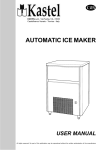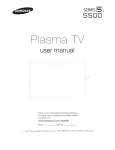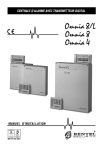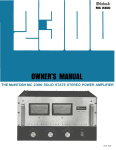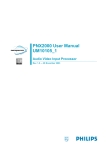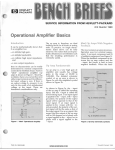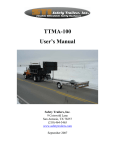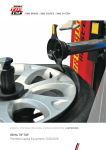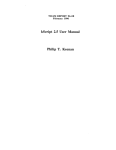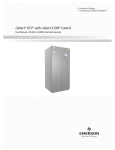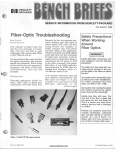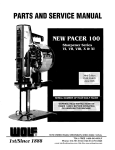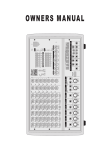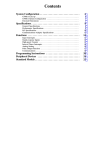Download Barney Oliver Amplifier Manual
Transcript
HP Archive This vintage Hewlett Packard document was preserved and distributed by www.hparchive.com Please visit us on the web ! Thanks to on-line curator: Kenneth Kuhn for supplying and scanning this vintage document. (j~ ~ ,. AMPUFIER ========== Table of Contents The Barney Oliver Audio Amplifier TABLE OF CONTENTS Page Section I. II. III. DESCRIPTION A. General B. Specifications 1-1 1-2 FRONT PANEL CONTROLS A. INPUT Selector B. MODE Switch. . C. FILTER Switch . D. VOLUME Control E. Phono Equalization Switch (-6dB, RIAA, +6dB) F. BASS Switch (FLAT, BOOST) . . . . . . . 2-1 2-1 2-1 2-1 2-2 2-2 INSTALLATION A. Phono Connections . B. Use of Phonograph Pickups Other Than Shure V-15 Type II C. Speaker Connections . . . . . . . . D. Speaker Placement . . . . . . . . . . E. Line Voltage, Frequency and Line Fusing . F. 115/230 Volt Amplifiers (European Units) . G. Installing Amplifier in an Existing Cabinet H. Assembly of Walnut or Teak Enclosure I. Rack Mounting Cabinet . . J. Pictures and Outline Drawing 3-1 3-2 3-2 3-2 3-3 3-3 3-3 3-3 3-4 3-4 IV. LOUDSPEAKER PHASING 4-1 v CIRCUIT DESCRIPTIONS A. Phono Pre-Amplifier B. Filter Board C. Power Amplifier D. Power Supply . 5-1 5-1 5-2 5-2 VI. VII. CIRCUIT DIAGRAMS A. Phono Pre-Amplifier B. Filter and Controls . C. Power Amplifier one Channel Dl. Power Supply . . . . . . D2. Primary Circuits . . . . . E; Deck Wiring (See Sections VI, A, B, C, and D.) PARTS LISTS A. Phono Pre-Amplifier B. Filter Board C. Power Amplifier D. Power Supply E. Deck Parts . . 6-1 6-2 6-3 6-4 6-5 7-1 7-2 7-3 7-4 7-5 Description The Barney Oliver Audio Amplifier SECTION I DESCRIPTION A. GENERAL The Barney Oliver Amplifier is a high quality all solid state audio amplifier designed for two channel stereo sound reproduction in the home, in studios, and in small to medium sized auditoriums. It is intended for use with full frequency range 8 to 16 ohm speaker systems and with signal sources (phonograph pickups, tape decks, AM and FM tunners) that are themselves flat enough to require little or no equalization. In addition to the power amplifiers, the unit includes phono preamplifiers designed to operate from any of several magnetic phono cartridges. These preamplifiers provide the necessary equalization for the RIAA recording characteristic. Additional plugin preamplifier boards have been designed for direct moving coil microphone input or for direct input from low-level, high impedance sources. Adding this feature will require that the user build the preamplifier boards, install and wire printed circuit connectors in the deck, drill front or rear panel holes as required, and modify selector switch wiring. Hum and distortion are inaudible. As a result of careful attention to filtering and to lead routing on printed circuit boards, the residual hum is well below thermal noise (which itself has been minimized by optimum input stage design). The output stages of the amplifiers are operated class-B to reduce standby power drain and are biased and locally degenerated to reduce crossover distortion. A large amount of overall negative feedback, ranging from over 100 dB loop gain at dc and low frequencies to over 50 dB at the top of the audio range further reduces any remaining harmonic and inter-modulation distortion. Since the /-l-circuits are direct coupled, overload produces no long time constant transients; the peaks are simply clipped and the original waveform resumes at its proper value immediately afterward. Because of the large amount of feedback, signals only a fraction of a dB below actual overload typically show a total distortion over 75 dB below the fundamental. Bridged-tee networks in the 8-circuits of the amplifiers, and active filters in the mixing and control board, enable the low-end response to be maintained down to 20 Hz and to fall off very rapidly below the audible range. This prevents the amplifier and loudspeakers from being driven beyond their linear excursions by low frequency transients arising from such sources as warped records or breath blasts into microphones. The high end response is reduced at 18 dB per octave above 20 kc by another pair of active filters to protect the amplifiers against overload by, or rectification of, strong r-f signals. The power amplifiers are protected against damage from accidental short-circuits at their outputs. Momentary shorts will have no effect, But sustained shorts may blow one or more of the protective fuses. In addition, all power supply outputs are either current limited or fused so that shorts from test probes will in general cause no damage. Finally, considerable effort was devoted to reducing switching transients. A balanced build-up and decay of power supply voltages and careful balancing of function drops minimizes the turn-on transients in the amplifiers. A slow turn-on in the low voltage regulated supplies further reduces the turn-on transient from the pre-amplifiers. 1-1 The Barney Oliver Audio Amplifier Description SPECIFICATIONS OUTPUT PER CHANNEL SPEAKER Z FREQUENCY RESPONSE +1 CONTINUOUS* AUDIO PEAK 16 ::::::36 W ::::::90W 8 ::::::50W ::::::160W 4 ** ::::::80W I +1 + iI II~I" h!I~~T ,OUT : I' i ! ~ o+l-J+.11++ 1"'-N~-+----==t"'+-++----1I--+-+++-""'od-.=-+-+-I_+____1 i ! : I I '\ I ~ I! ~ -51 f < 0.01%, 2 mw to max. power, all freqs. ~~ 1 ~~!\ ... 1\. . ~ -'-+1-++----+---+----+-++----1-+-+-+-Hf ~ ~I~- II HARMONIC DISTORTION I I Ii: i I I Frequency Response m \ -101+1 1/ 1 I i I \ !\ -1~t--+-+++_-+--+----+-++-_I1__+-+_+_1_+_\h...._+___+_I_1_+____1 : Iii HUM AND NOISE Power Amplifier: 100 db below max. output t Phono Preamp: 84 db below one volt output ~o -1010 100 ~oo 1000 ~I \Ir\~ lrr ~I 1001 FREQUENCY INPUT VOLTAGE FOR FULL OUTPUT Tuner, Tape, Aux 1, Aux 2: Phono: ~ 5 mv rms ~1.0 volt rms INPUT IMPEDANCE Tuner, Tape, Aux 1, Aux 2: 100 K n Phono: Optimized for SHURE V-15 Type II Pickup. CONTROLS INPUT: TUNER, TAPE, PHONO, AUX 1, AUX 2. MODE: STEREO - DIR(ect), REV(erse), L, R MONO-DUAL, L, R *Both channels operating simultaneously at maximum output. **Continuous high power operation at less than 8 n not recommended. See instruction manual. t Hum pickup by phono cartridge may cause this figure to be exceeded. 1-2 CONTROLS (Cont'd.) FILTER: Controls active h.f roll-off filter > 18 dB/octave with comer at 5, 8, 10 or 20 kHz. Includes 30 dB notch at 10 kHz in 5 and 8 kHz positions. VOLUME: Dual precision attenuator, 60 dB range, 2 dB steps. Eliminates need for balance control. BASS: FLAT, BOOST Response: RIAA, + 6 dB, - 6 dB SIZE: 16.72" (425 mm) wide, 5.0" (127 mm) high, 10.93" (278 mm) deep behind panel. WEIGHT Approximately 20 pounds net without case. POWER REQUIREMENTS 115 or 230 V.A.C. ± 10%, 50-60 Hz, 20 W standby power, 135 W at full output into 16 n (both channels). Front Panel Controls The Barney Oliver Audio Amplifier SECTION II FRONTPANELCONTROLS Simplicity of operation has been achieved with a minimum of controls. It is a good idea to mark with a colored dot the "normal" settings of special purpose controls so that the inexperienced or technically naive operator need only ch-eck these settings and achieve good results using only the input selector and volume control. A. DUAL Both channels mixed and delivered to both speakers. L Monophonic reproduction of "left" channel over both speakers. R Monophonic reproduction of "right" channel over both speakers. INPUT Selector This switch allows a choice of anyone of five inputs. From left to right these are: TUNER Accepts input at line level (0 dBm) from FM, AM, or FM/AM tuner. TAPE Accepts input at line level (0 dBm) from an equalized stereo or single channel tape deck. PHONO Accepts input from a magnetic stereo phonograph pickup. AUX 1 Accepts inputs from any linelevel audio circuit such as tuners, tape decks or other sources. AUX2 B. The Land R positions allow monophonic tapes and other signal sources to be reproduced over either one (STEREO side) or both (MONO side) speakers. C. FILTER Switch This control allows various high frequency roll-offs to be introduced. From left to right the positions are: 5 Introduces a high frequency cutoff at 5 kHz, with a null at 10 kHz. Useful for noisy 78 rpm records and AM reception. 8 Introduces a high frequency cutoff at 8 kHz with a null at 10 kHz. Useful for good 78 rpm records and AM reception. 10 Introduces a maximally flat 18 dB/octave cutoff at 10 kHz. Useful for slightly noisy conditions. 20 Normal position. Introduces a maximally flat 18 dB/octave cutoff at 20 kHz. MODE Switch This control allows the left and right channels of the input to be delivered to the speakers in various ways. The center position is normal for stereo operation. From left to right the modes are: L Left stereo channel only to left speaker. R Right stereo channel only to right speaker. REV Stereo channels reversed. Left channel to right speaker, right channel to left speaker. D. DIR Direct presentation. Each stereo channel to corresponding speaker -Normal position. VOLUME Control A dual precision attenuator allows adjustment of the sound level in 2 dB (or scarcely perceptible) steps over a 60 dB range. Because the attenuation is precisely balanced and because the feedback assures equal gain in both channels, the nuisance and hazard of an improperly set 2-1 Front Panel Controls balance control are eliminated. (Note: Identical speakers are assumed. Good quality speakers of good manufacture will ordinarily be within 1 dB of each other over the audio range. Likewise for the two channels of a good phono-cartridge. However, the perfectionist may want to test his components and introduce appropriate loss into the "hot" side.) The Barney Oliver Audio Amplifier enhance the high end to compensate for the deficiencies of the usual playback system. If your speakers are flat, the -6 dB position will help correct this practice. If you find the +6 dB position better in the majority of cases, your speakers (or your ears) need attention. F. E. Phono Equalization Switch (-6 dB, RIAA, +6 dB) Below the INPUT selector control, and effective only in the PHONO position of that control, a three-position slide switch allows some compensation for recording defects. In the center (Normal) position, this switch provides the standard RIAA equalization. In the left position, the high frequency response is dropped by 6 dB, while in the right position, the response is enhanced by 6 dB. Some manufacturers (such as Deutsche Gramophone) conscientiously adhere to RIAA specifications, while others (names supplied on request) 2-2 BASS Switch (FLAT, BOOST) Located below the high frequency FILTER control is the two-position BASS switch. In the BOOST position, the switch raises the response at 6 dB/octave from 80 Hz down to 20 Hz. In the BOOST position, approximate compensation is provided for the usual low-end roll-off of good speakers. (Two poles at 40 - 50 Hz). If you are fortunate enough to have an overdamped pair of woofers with real poles at 80 Hz and 20 Hz (such as LE-15A's or ALTEC 411-A's in 9 cu. ft. or larger enclosures), the BOOST position will closely compensate the low-end roll-off down to the bottom of the audio range. For very high sound levels, the FLAT position is recommended. Installation The Barney Oliver Audio Amplifier SECTION III INSTALLATION A. PHONO CONNECTIONS Special precautions must be observed for the PHONO input. Because a combination of shunt and series feedback is used to control the impedance faced by the cartridge and thereby produce the high end roll-off required by the RIAA recording characteristic, the "LOW" side of each input is not grounded inside the amplifier and THESE MUST NOT BE GROUNDED OR CONNECTED TOGETHER externally. (See Section V, A. for further information.) If coaxial or shielded wires are used for each channel, the two inner shields TO GROUND CONNECTION ON REAR Of AMPLIfiER NOTE: must be insulated from each other and from the outer shield around both as shown in Figure l. In some cartridges, the LOW side of one or both channels is grounded to the case by a thin strap at one or both LOW terminals. IF PRESENT, THESE GROUNDING STRAPS MUST BE REMOVED BY PRYING THEM OUT AND OFF WITH A LARGE NEEDLE OR PICK. The overall shield should be connected to the turntable frame at one end and to the amplifier chassis at the other end using the binding post provided. After this is done, test that both channels are isolated from ground before connecting them to the amplifier. TO CHASSIS Of TURNTABLE OR CHANGER lead connecting pickup to amplifier (including inner shields). Inner shields must not be grounded at either end. Also inner shields must not be connected together at any point (including at or inside pickup). Cables should have insulation over shields. Outer' shield must not make contact with any In some locations the outer shield may not be necessary; in such cases, turntable or changer chassis should be connected to amplifier chassis (ground terminal on rear) with a separate wire, preferably insulated. Figure 1. Phono Connections 3-1 Installation The Barney Oliver Audio Amplifier The phono cartridge should be located as far as is convenient from any transformers, motors, or other source of AC magnetic field. With proper installation and a good cartridge, no AC hum should be audible even at the full setting of the volume control and with bass boost. B. USE OF PHONOGRAPH PICKUPS OTHER THAN SHURE V15 TYPE II The phonograph pre-amplifiers as shipped are optimized for the Shure V15 Type II pickup. Other good quality pickups can be used, but a resistor change on each of the phono pre-amp boards may be required. The resistors in question are designated R1 as shown near the left side of the pre-amp schematic in Section VI, A. To determine the optimum value for R1 for a given pickup, the inductance and resistance of the pickup must be known. The value for resistor R1 may then be calculated by using the following equation: r\ L 6 ~ \R 1 =_0_ x 10 - 100 R - 20K .75 0 Where L o is pickup inductance in Henries, R o is pickup internal resistance in ohms, and R1 is in ohms. Once the value for R1 has been calculated R1 resistors on each of the two phono pre-amJ boards should be changed to the proper value. For additional information, see Section V, A. LEFT SPEAKER C. SPEAKER CONNECTIONS The amplifier may be located at any convenient distance from the loudspeakers. Twisted pairs of No. 18 wire or larger or ordinary zip-cord may be used to connect the amplifiers to the speakers if the distance is under 100 feet. For longer distances, heavier conductors are recommended. In general the d-c resistance of the cables or cords should not exceed 5% of the speaker impedance. Connection to the amplifier outputs is via the two-terminal polarized Jones sockets at the rear of the amplifier. The cords or cables must be soldered to the mating plugs provided, taking care to avoid internal short circuits from wire strands or solder bridges. It is good practice to insulate the wire and lugs from each other with electrical tape or heat shrinkable tubing inside the plug sleeve after soldering. D. SPEAKER PLACEMENT The loudspeakers should be located at the ends of the base of an isosceles triangle with the listener at the apex. The apex angle of this triangle, i.e., the angle between the lines of sight to the two speakers should be about 15 0 to 45 0 , as shown in Figure 2. Good sound quality will then be heard up to 45 0 on either side of the perpendicular bisector of the line between the speakers. RIGHT SPEAKER ~~~~ I I I I I I I I 3-2 Figure 2. Installa.tion The Barney Oliver Audio Amplifier E. LINE VOLTAGE, FREQUENCY AND LINE FUSING G. INSTALLING AMPLIFIER IN AN EXISTING CABINET 115V/230V AMPLIFIERS (European Units) If the amplifier is to be installed in an existing cabinet, careful attention should be paid to the outline drawing shown in Sect~op III, J. Because certain components, especially the power supply capacitors, are quite large, it will be seen that the overhang at the top of the front panel is not very great and at the bottom edge is virtulllly zero. This will require considerable care in cutting the necessary hole in the cabinet. It is strongly recommended that the amplifier be examined in detail before laying out this hole to prevent costly mistakes. Referring to the side view in the outline drawing in Section III, J., it will be seen that overall front panel height is 5", that the rear panel height is 4.85", and that the side gussets 'are 4.48" high. This will make possible the use of a hole somewhat less than 4.85" high, if the amplifier can be tipped slightly as it is inserted. Units shipped to Europe (and in a few cases within the United States) are equipped with 115/230V power transformers. Front panel overhang at each side is approximately 1,4", requiring less precision in the horizontal dimension. Unless specifically tagged otherwise, amplifiers operate only on 115V ac line. 115V amplifiers have single power transformer primaries and cannot be connected for 230V operation. (An external 230-115V step-down transformer may be used.) The proper line fuse for 115V units is 1.6 amp, slow-blow. Satisfactory operation will be obtained with line voltages within ±10% of the nominal (115V or 230V) value. The line frequency should be 50 Hz or greater. A grounding or three wire socket is recommended but not essential. If the chassis is not grounded through the power cord, a separate ground may be needed to get rid of hum on phono, mike or other low level inputs. F. Units shipped to Europe will be connected for 230V operation and will be equipped with 0.8 amp slow-blow fuses. Because of the variety of ac plugs used, amplifiers shipped to Europe will not include line cords. The line connector on the rear of the amplifier is compatible with European line cords, and it is assumed that the user can obtain the proper cord. Units connected for 230 operation will be prominently tagged. 115/230 V amplifiers shipped within the United States will be connected for 115V operation, will use 1.6 amp slow-blow fuses, and will be equipped with standard line cords. These units will be tagged to indicate 115/230 capability. Amplifiers with 115/230V power transformers may be reconnected by the user for either line voltage. 115V operation requires connecting the two halves of the transformer primary in parallel; for 230V, the two halves must be connected in series. -NOTEWhen reconnecting transformer primaries, care must be taken to insure that windings are connected in an "aiding sense" (instantaneous flux produced by both windings must have the same polarity). The line fuse must be changed when changing the line voltage (1.6 amp for 115V; .8 amp for 230V). H. ASSEMBLY OF WALNUT OR TEAK ENCLOSURE If the walnut or teak enclosure option was included with your amplifier, it may be assembled as outlined below. (See Section III, J. f~r picture of assembled enclosure.) The enclosure kit consists of the following: Two wood side panels (one right and one left). Black vinyl-clad aluminum top cover with retaining screw. Four 10-32 flat-head Allen screws and nuts for attaching side panels to amplifier. Wood side panels have been sanded but not finished. It is recommended that the wood pieces be finish sanded with fine sandpaper such as 400 or 600 grit. They can then be finished as you please. One quick, simple and beautiful finish which can be done by most anyone anywhere is an oil finish, with or without stain. Most paint stores and many hardware stores sell Danish oil finish materials (one brand is Watco). If a high-gloss finish is desired, it will be necessary to apply filler to the wood before staining and applying finish. For this process the user is referred to his friendly paint store or cabinet shop. 3-3 The Barney Oliver Audio Amplifier Installation ASSEMBLY INSTRUCTIONS Attach the wood side panels to the amplifier with the Allen screws and nuts. It will be noted that the side panels are notched across one end to clear the front panel overhang and to allow the wood panel to extend slightly forward of the front panel. Near one edge of each wood panel is a slot extending the full length. The panel should be attached so that these slots are at the top of the amplifier and face inboard. The aluminum top cover slides into the slots just mentioned, with the front edge fitting into a slot at the top rear of the front panel. screw through the top cover. It may be necessary to adjust the positions of the wood side panels to permit the top cover to slide into place without interference from side gussets or other amplifier parts. I. If your amplifier was furnished in an HP type cabinet, it can be rack mounted by use of the standard rack mount kit shipped with the instrument. Instructions are included with the kit. J. The rear edge of the top cover lies on the top of the back panel and is secured with a single 3-4 RACK MOUNTING CABINET PICTURES AND OUTLINE DRAWING (See following page.) . 3 8 i n ' i t - - - lo.93in.~ (10mm) (278mm) I ~~~~ I i" : I iIii I @ I ~:~;'~::i-----l I r t [lI(W~;:;:r 16.72 in. (425mm) I _,12.11in. (308mml--i J ~ r 4.48in. 4.85in. (114mm) (123mm) 5.00in. (I27mm) I ~---------+J------<. 0 c::::J I NOTE: CASE IS AN EXTRA·PRICE OPTION The Barney Oliver Audio Amplifier Loudspeaker Phasing SECTION IV LOUDSPEAKER PHASING Proper stereo reproduction requires that the loudspeakers be properly phased. To check this, insert a reversing switch in the leads to one speaker as shown in Figure 3. Turn on the power and the signal sources and bring up the volume. Set the MODE switch to "DUAL". Station yourself exactly midway between the speakers and about three feet in front of the plane of their front baffles. Try reversing the switch. In the proper position the sound should appear to originate from dead ahead of you. In the improper position this illusion disappears and both sources are heard independently. Unless the speakers are matched, the above test is difficult,' but with identical speakers the illusion is very striking and the test is easy to perform. Reconnect the speaker pre- serving the proper polarity. This test need only be done once. Return the MODE switch to the normal STEREO-DIRECT position. If, on the average, one channel seems louder than the other, throw the MODE switch to the STEREO-REVERSE position. If the loud channel shifts to the opposite speaker the signal source or program material is defective. If the loud channel stays with the same speaker, the other speaker is less efficient. If the speakers are supposedly identical, the weak one may be defective. (Check the doc resistance of the speakers. These should be the same within 5%.) The use of different speakers for the two channels is not recommended. AMPLIFIER Note: dl must equal d2 Figure 3. 4-1 Circuit Description The Barney Oliver Audio Amplifier SECTION V CIRCUIT DESCRIPTIONS A. PHONO-PRE-AMPLIFIER The phono pre-amplifier uses a combination of series and shunt feedback to the input terminals to provide a resistive input impedance of the proper value to produce, together with the self inductance of the pickup, the required RIAA high frequency roll-off above 2120 Hz. If L o is the pickup inductance and R o the resistance, and if R is the input resistance to the pre-amp we require that L 6 R +oR = 75 x 10- seconds o This leads to the value of R1 given in the schematic. As supplied, R1 is appropriate for the Shure V-15 Type II cartridge. To provide the ±6 dB variation of high end response, the shunt feedback is halved or doubled. The series feedback is applied to the low end of the pickup windings which places these ends (normally the outer shields of coaxial lines) 10 n above ground. To avoid hum and RF pickup it is recommended that an outer shield insulated from both inner shields be used. This shield should connect the record player frame to the amplifier chassis. A balanced differential stage is used at the input to avoid drift and RF rectification. The remainder of the amplifier is similar to the power amplifier except for power level. The output Class B stage can supply a 600 n line or headphones at line level (0 dBm) without appreciable distortion. The low end bass boost of the RIAA characteristic below 500 Hz is provided by C12 and R3 + R4 + R5 + R6 and R28. The low end cutoff is provided by C2 and C3 together with C4, C5 and R10. This combination provides unity d-c external gain and a fourth order maximally flat low-end cutoff at about 16 to 20 Hz. Great care was used to make the projected area of the input circuit zero in all directions by properly routing the conductors and by providing the loops shown. This minimizes the magnetic coupling to the power transformer and reduces the hum below audibility. (If you notice any hum, it's from coupling directly to the cartridge.) Because the input impedance is low (about 10 K n ) cable capacitance has no effect on the high end response for lengths up to 10 or 20 feet depending on the cable used. Many of the components that may puzzle you, such as Q3 or CR8 or such as CR1, CR2, CR5, etc., are there to avoid tum on transients or avoid emitter base breakdown. Everything has a function, but invincible fatigue prevents me from going into all the gory details. B. FILTER BOARD The filter board provides a sharp low-end cutoff below 16 Hz to protect the speakers against large useless cone exursions, and a controllable high-end cutoff to suppress the high frequencies with noisy or distorted program material. The board contains four unity gain amplifiers consisting of two cascaded emitter followers (example: Q3 and Q5) with constant current supplies (example: Q1 and Q7). This combination provides very high input impedance, very low output impedance and low distortion. The two input unity gain amplifiers are coupled to the input selector switch through active high pass filters that drop rapidly in transmission below 16 Hz (example: C1, R1, C3, R7, Q3, Q5). The output of these feed the mode selector switch. The output unity gain amplifiers provide drive for the dual precision volume control and are coupled to the mode selector switch via active low-pass filters. These are three pole filters, two of the poles being provided by the input RC networks and the remaining poles (and zeros) by the shunt branch at the output. Potentiometers are provided to supply the base currents of the input emitter followers and thereby enable the voltages at terminals 5, 4, 20 and 21 to be set equal to zero. This eliminates transients when the mode and filter switches are switched. 5-1 The Barney Oliver Audio Amplifier Circuit Description C. POWER AMPLIFIER The output stage of the power amplifier is a cascaded complementary emitter follower comprising transistors Q12* and Q13*, with QlO and Qll as their drivers. Operating point stability is provided by resistors R5* and R6* and by currents from current source Q8 flowing through CR7, CR9, R22, CR8 and CR6. The power diodes CRI * and CR2* shunt R5* and R6* at high signal levels to avoid large voltage drops in these resistors. Inductance Ll * protects the output stages from the effects of capacitive cable loads at very high frequencies while R8* eliminates any series resonance with this capacity. Diodes CRlO, CRll, CR12 and CR13 provide output current limitation. Together with fuses F* these provide output short circuit protection. The output stages are driven by emitter follower Q9, which has current limitation in the collector. The input stage consists of a differential pair, Ql and Q2, whose emitter currents are supplied by Q4. The input signal is applied to the base of Ql and the feedback to the base of Q2. The output collector swing of Ql is limited by CR2 and CR3 to protect the emitter-base junctions of the second stage comprising Q5 and Q7. The loop gain at d-c and low frequencies is extremely high (> 100 dB). The primary cutoff for the loop gain at high frequencies is the basecollector capacitance of Q7. Thus the loop gain falls at 6 dB/octave to reach a value of about 60 dB at 10 kHz. Inductors Ll and L2 introduce a second pole at 16 kHz above which the loop gain falls at 12 dB/octave to about 200 kHz, where C6 begins to shunt R16 producing a high end cutoff in the amplifier and reducing the loop gain cutoff rate to 6 dB/octave once more. Gain crossover is at about 1 MHz. The bridged-T comprising C3, C4, Rll, and R12 increases the loop gain below 16 Hz and reduces the external gain to unity at d-c. The poles in the external gain are slightly complex so the low end response rises slightly at the low end before dropping off. In the bass-boost position C7 and C8 together with R16 and R17 produce a pole at 16 Hz and a zero at 80 Hz in the external gain. Thus the gain rises at 6 dB/octave below 80 Hz, to compensate for the low end roll-off of most loudspeakers. "Located on chassis. See rfghthand portion of Power Amplifier Schematic. Section VI. C. 5-2 Transistor Q3 supplies current to two potentiometers R4 and R5, which are adjusted so that the currents through R2 and R3 supply the base currents of Ql and Q2. By adjusting R5 with the input terminals shorted (volume control at minimum) and R4 with the input terminals open (or with the volume control at maximum) to give zero volts out of the amplifier, this condition will hold for any impedance the amplifier faces (any volume control setting). D. POWER SUPPLY All supply voltages (50V, 40V, 20V and lOY) are available in both polarities. The main supply (± 40V) is rectified by diodes CRl, CR2, CR3, and CR4 in a double full wave configuration. Filtering is by capacitors C3 and C4. This supply has a substantial amount of ripple, especially under load, but the power amplifier by-passing is such that this produces negligible hum in the amplifier output. -WARNINGThe terminals and leads of C3 and C4 are not current protected. Do not short to ground or to each other. (You'll ruin your screwdriver. ) The +50V supplies are really 10V supplies floated on the +40V supplies respectively. They will show about the same ripple as the latter. Transistors Ql and Q2 with their associated circuitry provide protective current limits on the +50V supplies. Zener diodes CR13 and CR14 establish the reference voltages for the ± 20V supplies obtained from the cascaded emitter followers Q3-Q5, and Q4-Q6. The rate of rise and fall of these supplies during tum on and turn off is determined by the two stage active filters comprising R9, C5, R13 and R15, C7 and transistor Q3 for the + 20V supply and RIO, C6, R14 and R16, C8, and transistor Q4 for the -20 V supply. Diode CR17 compensates for junction drops in Q5 and Q7, while CR18 compensates for junction drops in Q6 and Q8. Resistors Rll and R12 compensate for the initial charging currents in C5 and C6 so that these currents do not flow through R17, R19, CR17 and R18, R20, CR18. The Barney Oliver Audio Amplifier Resistors R17 and R19 as well as R18 and R20 are dividers to develop the ± 10V reference. The ± 10V outputs are taken from emitter followers Q7 and Q8. CR15 and CR16 provide short circuit protection and transistors Q9 and QI0 protect the emitters of Q7 and Q8 against reverse voltage from shorts between the 10 and 20 volt supplies. Circuit Description The 10 and 20 volt supplies are regulated and essentially ripple free. The maximum steady current ratings of the various supplies are: Max Current Supply 18 ma ±10V 70ma ±20V 3 amps ±40V 0.5 amps ±50V 5-3 SECTION VI CIRCUIT DIAGRAMS r-------------------· I 03 3-020 I I I I I I + C6 15fL R7 lOOK RS lOOK CRl 1-040 CR2 1-040 = 4-221 I La Rl 02 01 4-221 SHURE V15 ETC. I I I I I I I 909K CR3 1-040 CR4 1-040 C1 30pF 3 4 I Q4 4-071 R2 20K R9 46.4K 54 -6db 16 I I I I I I I I I I I I I L R4 511.n. R3 1100n R5 511.n. R6 lOon C2 300J-LF NP 300~~ LOOP C3 -= . - - --- -- - -- - - - - - - - - - - ---- - -- - - - - - - - - -----.,I 03 3-020 I I RI9 215.n. 11 ~~-"'--"'-----""----~~-_.-IVv'\----"""1,,",""----------o+20V I + R15 26.1K Rll 5.11K 05 3-020 R7 lOOK I R23 511,(1 I I 07 3-020 I I I I RS lOOK CR1 1-040 I I I I Cll T 1000pF -= 09 4-071 CR2 1-040 01 4-221 02 4-221 I I I RI3 10K CR4 1-040 I R25 51.1.fl. CR7 1-040 CR3 1-040 I I 011 4-071 R22 10K R17 200.0. 17 I 1 R29 5.11 K 18 010 3-020 CR8 1-040 I I I I 08 4-071 4-071 06 4-071 R12 5.llK R9 46.4K + R16 56.2K OUTPUT TO SELECTOR SWITCH I R26 51. 1.fl. CR6 1-040 Q4 I R27 51.1.fl. I I I R1S 10K C10 TIOOO pF -= R24 511.fl. Cl2 .15fLF I I I R2S 21.5K I R20 215.0. 17 ....----+-....--+-----....- - - - -....---'VV'V---....----+-----OO -20V R6 10.0. R14 120K I I I LOOP tl RIO 20.0. C3 300~~ LOOP I I -= -= I I I I _ _ _ _ _ _ _ _ _ _ _ _ _ _ _ _ _ _ _ _ _ _ _ _ _ _ _ _ _ _ _ _ _ _ _ _ _ _ _ _ _ _ _ _ _ JI x 10 6 -IOOR o -20K * R1 =...!:..2. .75 L o IN H, R o IN .fl. 5mV PRODUCES 1 VOLT OUT AT 1KHz ALL RESISTORS l/SW METAL FILM UNLESS OTHERWISE NOTED. 3ZIA Phono Preamplifier 1- - - - - - - - - - - - - - - --~ I I I I I I I PHONO TAPE~AUX1 TU NER-f t L 51 AUX 2 ~ ~51A I 2 ~ R15 10K OUTPUT +IOV +/OV I STERE0 I I I I I R3 lOOK [ L 1 iMONO] 51' ~~, 52 I I I 53 I I -IOV I Cl .22 I I I I RI3 3.16K 1 1-..¢:5~+-+.J-:-~t-;:;-v:;:.:,JlVV\r~=:Y21 536 1 I CII I .001: r~l~ Rl 23.7K ~ 10 I I I 1 I I I I -IOV 16 1 -20V CI~ . 0181 L..---.-v-"""'jr r I CI7 .03: 14 22 1 -= i-- I I I I I I I I I I I I TUNER MONITOR I I I +20V FILTER MODE INPUT 121 3 2*1 + C5 10fLF *1 + 10fLF CI9.C L..-----r-.....,r +20V~C7 +/OV~I-~P-' 1 C8 ~IOfLF -/OV~+ I C6 ~IOfLF -20V~+ RUMBLE FILTER AND BUFFER AMP +20V o +/OV o 0 I I I I ~ ~516 PHONO ~ TUNER RI6 MONITOR 10K OUTPUT R4 lOOK I +/OV~"""",,'V,,.-'V-IOV I I 1 I .g I 1 I I I 1 I 1 F I I I I 1 R2 23.7K I R14 1 1 1 1.96K CI2 1 Cl' .0012 r I I L -IOV -20V I ---I: 151C18 .O~ I I I I C20 .01 I L- I IIL I o~~ I I I I 53EI I _ f 13 J _ _ FILTER MODE 51' «, STERE0 [ 1 iMONO] --1 r - - - - - -- - - -- -- - - - - - - I 1 52 S3 I I +IOV + IOV I I +20V I 1 1 1 1 I 1.96K RI9 lOOK 1 I I R23 I I RI5 4.7M I 3R!~K 211 I~~.n.-IOV --'\I\I'v-+-~---+-V-./'v-f'--+1 I :-.......+6-O-+-....:vVv--...... I 4 S3BI S3A I Cll lO~r"' 10 1 CI3 .00125fl-F C25 I .0047fl-FI 9 CI5 .018fl-F 10K STEPPED ATTENUATOR rl-O--.....J 14 1 CI7.033fl-F 12 1 RIA TO POWER AMP 1 1 I I S3C I ICI .0047 I fl-F t---+---JI t--' 16 1 * * * 1 5 C19 .01fl-F -20V -IOV L-------.:..:<>--~I_. ...- - - - - - - - - - - - - -... d~~ Ll 31.6mHl·uu o o 0 ACTIVE FILTER +/OV +/OV +20V R24 1.96K R20 .---",IOOK RI6 4.7M RI4 3.16K 4 R18 -IOV 100.n. 20 S3D lc2 .0047fl-F I I I I 17 1 10K STEPPED ATTENUATOR P I C26 .0047fl-F 110 * pt---<?--. ... .018fl-F 131 C20 .01fl-F L.. RIB TO POWER AMP I CI6 15'C18.033fl-F -20V -IOV ~(_-.,~-....- - - - - - - - - - - - - -.... _ _ _ _ _ _ _ _ _ _ _ _ _ _ _ _ _ _ _ ...1 S3F '6* .06~~~,d L2 I 31.6mH _ - 1 1 _ _ _ _ _ _ _ _ _ _ _ _ _ _ _ _ _ _ _ _ _ _ _ _ _ _ _ _ _ _ _ _ _ _ _ _ _ _ -.JI PNP - 2N3906, 1853 -0036 NPN- 2N3904, 1854-0215 Notes: This Boord Utilizes Two Separate Connectors. Terminals on the Larger Connector are Lobled 1 thru 22; Terminals on the Smaller Connector are Shown as 1* thru 10*. All Resistors 1/8 W Metal Film Unless Otherwise Noted. C27* and C28* Selected To Center 10 KHz Notch at 10KHz ± 100Hz 1ZI B Filter and Controls ,---------------------------------CR1 1-040 R6 10K RIO 10K R7 10K + RI3 5.11 K R19 5.11K C5 50f-LF 03 CR2 1-040 2N5401 05 CR3 2N5401 07 2N5401 Adjust for 0 V at Output with Volume 'tF""~ Adjust for OV at Output with Volume at Zero R4 50K Amplifier Input from Daven Attenuator R5 C6 120pF r -.....-<50K R2 1.5M 2 I R1 1/4w 51.1.0. I I R16 5.l1K R12 200.(1 11 -= C8 .027f-LF R17 20K I I I ~ C3 T100f-LF NP -= R15 34.8K ~ 04 Current Source + 10-- - - - - ---- 06 2N5551 2N5551 C2 50f-LF "I 5.1 K ---------t--- . NOTES: / • --16 f~- \ *Select for Speaker Protection 2.0A 3AG Maximum Located on Back Pl,(el.)/ All Resistors 1I8W Metal Film Unless Otherwise Noted. 4 - Digit Number by Diodes is Derived from Part Number: CR1 , =190 J J 40 --..1-------- =1-040 ---------------------, R27 _ _ _ _ _ _. . I I 100 ........I'I'."""----¢13 .......- +50V RI9 5.IIK 05 o CR3 2N5401 07 2N5401 R23 909.n. These Parts on Chassis Cl0 'Jl000pF +40V lDo---Cl J5 )ut with R26 10K R22 75.0. C7 .4 p.F R2 1.96K R7 .05n. L1 Audio Out R8 J7, PI 51.1 n. OV R17 20K o CR4 1-040 CR8 CR6 -40V 06 2N5551 2N5551 R21 + 5.11K J6 I I I I 08 l: ! 50p.F R28 100 I ! 5 :.....---~~-....- -....---4I....- -...---4I~--'\1/1\4I'W---'9-50V I I -------------------------~ S5 ~/::--~-----------------------_~ BOOST ~ FLAT R9 lOOn. 1/2W Phone Jack J8 1ZIC Power Amplifier One Channel p o - - - - - - - - - - - - -_. I 01 I 2N4036 I 3~ I I I I Rl 10.11 CR9 I I I I CR5 750MA T1 + C1 350}.l-F + Notes: Power Transformer Primary Circuit Shown for 115V Models Only. For 115/230V Models, See :llI 02. CRll C2 350}.l-F I I I I I 4 Digit Number By Diodes and Transistors is Derived from Part Number: 01:: 1853-0045 = 3-045 I I I All Resistors 1/8 W Metal Film Unless Otherwise Noted. I R· 26. CRIO CR12 R2 10.0. I 02 I 2N2405 4-352- l - _. - - - - - - - - - ,.....---- - - - - - - - - - - - - - - I - - - -----, I --<j'+50V - -- ---- - - -- - - 01 I 2N4036 )3;:.-. :0:::4.::5 I I I I I R5 562.f1 Rl 10.f1 CR9 I R3 26.1K CRll R7 562.f1 I I 03 4-071 I CR5 750MA 05 R9 23.7K 2N2405 4-352 " ) . , , 4 - - - - - -.....----<; +20V + Cl 350fl-F R13 22K + CR15 9V RI5 2K + C5 100fl-F - C7 100fl-F R21 560 Cll Tl000pF R19 lK R25 10K 07 2N2405 +40V Rl1 42.2K + CR3 3A b"'--..:.4...:-3;.:5~2. ...- - t _ - - Q + 10 V R17 lK CR13 21.5V C3 15Kfl-F 09 CR17 C9 1000pF 2N4036 3-045 R23 10K 5\-.+--4--------.---, ClO 1000pF + CR4 CRIB C4 15Kfl-F R12 42.2K 010 RIB lK 2N2405 4-352 CR14 21.5V \-----4....--I4---+---....--u -40V R24 10K .--L~--....- - - + - - - o - 1 0 V 08 R20 lK + + _ R14 22K C2 350fl-F + C6 100fl-F - R26 10K CB 100fl-F R16 2K RIO 23.7K I I I ..,.1~-----""---o-20V 06 2N4036 3-045 I I I I 2N4036 3-045 R4 26.1K CRIO CR12 R8 562.f1 R6 562.f1 R2 1O.n. I I I I L-_. - - - - - - - - - - 02 'J----------------------------_~ -50V I 2N2405 4-352--- - .J ------ ----- 1lI 01 Power Supply 56 r---l FI J4 2 3 I O.SA S.B. I I I I 230 ±IO%V 50-400'V Jl RIO 47K I J2 J3 I I I L 4 -...., I I NE2 I L.___ _.J 5 115V/230V CONNECTED FOR 230V OPERATION 56 r--i 3 FI J4 2 I I I I I I I I ± 115 lO%V 50-400'V Jl J2 L 1.6A S.B. RIO 47K J3 4 -..., I I NE2 I _..J L ___ 5 115V 1230V CONNECTED FOR 115V OPERATION :ill 02 Primary Circuits Parts List The Barney Oliver Audio Amplifier SECTION VII PARTS LISTS A. PHONO PREAMPLIFIER Description Reference Designator C1 C2,C3,C4,C5 C6,C7,C8,C9 C10, Cll C12 CR1, CR2, CR3, CR4, CR5, CR6, CR7, CR8 30pF mica 300 ~F np 3V 15 ~F 20V tantalum 1,000pF ceramic .15 ~ F 10% mylar 0160-2199 30D1614 0180-1746 0150-0050 0160-0303 silicon diode 1901-0040 Q1, Q2 Q3 Q4 Q5 Q6 Q7 Q8,Q9 Q10 Qll transistor npn transistor pnp transistor npn transistor pnp transistor npn transistor pnp transistor npn transistor pnp transistor npn R1* Value is dependent upon characteristics of the phono pickup used. R1 = 909K for the Shure V-15 Type II. Otherwise calculate R1 per Section III, D. 20K 1l00n 5lln 1/8 W m.f. 10n lOOK 46.4K 20n 5.llK 10K 120K 26.1K 56.2K 200n 10K 215n 10K 5lln 5l.1n 2l.5K 5.llK R2 R3 R4,R5 R6 R7,R8 R9 R10 Rll, R12 R13 R14 R15 R16 R17 R18 R19, R20, R21 R22 R23, R24 R25, R26, R27 R28 R29, R30 Stock Number X2N4044 (special) X2N3904 (special) X2N3904 (special) X2N3904 (special) X2N3904 1854-0221 1853-0020 1854-0071 1853-0020 1854-0071 1853-0020 1854-0071 1853-0020 1854-0071 0757-0195* 0757-0449 0757-0424 0757-0416 0757-0346 0757-0465 0698-3162 0757-0458 0757-0438 0757-0442 0757-0467 0698-3159 0757-0459 0757-0407 0757-0442 0698-3441 0757-0442 0757-0814 0757-0394 0757-0199 0757-0438 7-1 Parts List The Barney Oliver Audio Amplifier B FILTER BOARD Reference Designation 7-2 Description Stock Number C1,C2,C3,C4 .221-' F mylar 0170-0086 C5,C6,C7,C8 10 0180-0374 C9,C10 100pF mica 0160-2204 Cll, C12 .00391.1- F mylar 0160-01~ C13,C14 .00125 1.1- F mylar 0160-0297 C15, C16 .0181.1- F mylar 0160-0302 C17,C18 .0331.1- F mylar 0160-0163 C19,C20 .011.1- F mylar 0160-0161 C21,C22 .001251.1- F mylar 0160-0297 C23,C24 .681.1- F mylar 0170-0039 C25,C26 .0047 F mylar 0160-0157 C27,C28 .00821.1- F mylar (See Schematic VI,B.) 0160-0160 L1,L2 Inductor, 31.6 mR special Q1, Q2, Q3, Q4 transistor pnp 2N3906 1853-0036 Q5, Q6, Q7, Q8 Q9 Q10, Qll, Q12 transistor npn 2N3904 1854-0215 Q13, Ql4, Q15, Q16 transistor pnp 2N3906 1853-0036 R1, R2 23.7K 0698-3158 R3,R4 lOOK pot 2100-2516 R5,R6 4.7 meg carbon 0684-4751 R7,R8 lOOK 0757-0465 R9, R10 lOOn carbon 0684-1011 Rll, R12 82.5K 0757-0463 R13,R14 1.96K 0698-0083 R15, R16 4.7 meg carbon 0684-4751 R17, R18 lOOn carbon 0684-1011 R19, R20 lOOK pot 2100-2516 R21, R22 82.5K 0757-0463 R23, R24 1.96K 0698-0083 R25, R26 4.64K 0698-3155 1.1- F 20V electrolytic The Barney Oliver Audio Amplifier C Parts List POWER AMPLIFIER Reference Designation Description Stock Number C1 .01 ~ F ceramic C2 50 C3 100JJ F 6V np 30D603 C4 22 JJ F tantalum 0180-0228 C5 50 C6 120pF mica 0160-2205 C7 .47~ 0170-0064 C8 .027~ C9 36pF mica 0160-2308 C10 1,000pF ceramic 0150-0050 Cll, C12, C13 50 ~ F 50V electrolytic 0180-0141 silicon diode 1901-0040 L1,L2 220 JJ H inductor 9140-0129 Q1, Q2 transistor npn 2N5551 1854-0474 Q3 transistor pnp 2N5401 1853-0264 Q4 transistor npn 2N5551 1854-0474 Q5 transitor pnp 2N5401 1853-0264 Q6 transistor npn 2N5551 1854-0474 Q7 transistor pnp 2N5401 1853-0264 Q8,Q9 transistor npn 2N5551 1854-0474 Q10 transistor pnp 2N4036 1853-0045 R1 51.1n 1/8 w 0757-0394 R2,R3 1.5 meg 1/4 w carbon 0614-1551 R4,R5 50K pot 2100-2517 R6,R7 10K 1/8 w m.f. 0757-0442 R8 3.16K 1/8 w 0757-0297 R9 5.llK 1/8 w m.f. 0757-0438 R10 10K 1/8 w m.f. 0757-0442 Rll, R12 200 n 1/8 w m.f. 0757-0407 R13, R14 5.llK 1/8 w m.f. 0757-0438 R15 34.8K 1/8 w m.f. 0757-0123 CR1, CR2, CR3, CR4, CR5, CR6, CR7, CR8, CR9, CR10, CRll, CR12, CR13 ~ ~ F 50V electrolytic F 50V electrolytic F F 0150-0093 0180-0141 0180-0141 0170-0066 7-3 The Barney Oliver Audio Amplifier Parts List C. POWER AMPLIFIER (Continued) Reference Designation Description Stock Number R16 5.llK 1/8 w m.f. 0757-0438 R17 20K 1/8 w m.f. 0757-0449 R18 10K 1/8 w m.f. 0757-0442 R19 5.llK 1/8 w m.f. 0757-0438 R20 20K 1/8 w m.f. 0757-0449 R21 5.llK 1/8 w m.f. 0757-0438 R22 R23 75 n 1/8 w m.f. 0757-0398 909n 1/8 w m.f. 0757-0422 R24 1.96K 1/8 w m.f. 0698-0083 R25 R26 R27, R28 lOOn 1/8 w m.f. 0757-0100 ·0757-0442 D. 10K 1/8 w m.f. loon 1/4 carbon 10% 0614-1011 POWER SUPPLY Reference Designation Description Stock Number C1,C2 350,u F 15V electrolytic 0180-2216 C3,C4 15000,u F 50V Sprague electrolytic 6821 Type 36D 153G050CC2A C5,C6.C7,C8 100,u F 15V electrolytic 0180-0061 C9, C10, Cll, C12 1000pF ceramic 0150-0050 CR1, CR2, CR3, CR4 diode, rectifier 3 amp 100V 1901-0200 CR5, CR6, CR7, CR8 diode, rectifier % amp 100V 1901-0158 CR9, CR10, CRll, CR12 diode, silicon 190t-0040 CR13, CR14 diode, Zener 21.5V 1902-3245 CR15, CR16 diode, Zener 9V 1902-3149 CR17, CR18 diode, silicon 1901-0040 Q1 Q2 transistor pnp 2N4036 transistor npn 2N2405 1853-0045 1854-0352 Q3 Q4 Q5 transistor npn X2N3904 transistor pnp (special) 1854-0071 transistor npn 2N2405 transistor pnp 2N4036 1853-0020 1854-0352 1853-0045 transistor npn 2N2405 1854-0352 Q8, Q9 transistor pnp 2N4036 1853-0045 Q10 transistor npn 2N2405 1854-0352 Q6 Q7 7-4 The Barney Oliver Audio Amplifier D. Parts List POWER SUPPLY (Continued) Description Reference Designation R1, R2 R3, R4 lOn Stock Number 0757-0346 0698-3159 R5, R6, R7, R8 R9, R10 26.1K 562 n lh watt 0757-0815 23.7K 0698-31)58 R11, R12 42.2K R13, R14 22K 0698-3450 0684-2231 R15, R16 1.96K 0698-0083 R17, R18, R19, R20 1K 0757-0280 R21, R22 562n lh watt 0757-0815 R23, R24, R25, R26 10K 0757-0442 E. DECK PARTS Reference Designation Description Stock Number Cl,C2 .0047 I-' F 0160-0155 C3,C4 .01 J.L F ceramic disc cap C5,C6 CR1, CR2 .01 J.L F mylar 200V diodes Motorola MR 841 0150-0093 0160-0161 Fl F2,F3 line fuse 1.6A slo-blo for 115V .8A slo-blo for 230V speaker fuses 2 amp max 2110-0005 2110-0020 2110-0003 Jl AC power connector 1251-2357 J2,J3 J4 power receptacles 1251-2073 line fuse holder 1400-0084 nut 2950-0038 washer 2190-0068 J5, J6 fuse clips 1400-0008 J7 speaker output jack (mates with PI) Cinch-Jones S-202-B J8 phono jack, ring tip sleeve Switchcraft 12B J9 phono preamp p.c. connector 18 pin 1251-0141 JI0 power amplifier p.c. connector 18 pin 1251-0141 J11 filter and control p.c. connector 27 pin 1251-0172 J12 filter and control p.c. connector 10 pin 1251-0166 JI3,JI4,JI5,JI6, J17,J18 input jacks fibre washers 1901-1038 GC Electronics 33-804 3050-0108 7-5 The Barney Oliver Audio Amplifier Parts List E. DECK PARTS (Continued) Description Reference Designation J19,J20 Stock Number sockets for Q12, Q13 1200-0041 anodized insulators 1200-0043 ~ inductor P1 speaker output plug (mates with J7) Cinch-Jones P-202-CCT Q12 power transistor pnp Motorola MJ4502 Q13 power transistor npn Motorola MJ802 R1 A& B dual 10K stepped attenuator Daven CPD-134M-H-4C687P 2dB/step with detents R2 R3, R4 1.96K 0698-0083 10rl2w 0698-3601 R5, R6 8.2rllh w R7 .05rl 0699-0003 0811-1826 R8 51.1rllJ4 w 0757-1000 R9 0757-0198 R10 100rl h w 47K lAi w R11, R12, R13, R14 3.16K, 1/8 w 0757-0279 R15, R16 10K 1/8 w 0757-0442 Sl input switch special S2 mode switch special S3 S4 filter switch phono equalization switch special 3101-0106 S5 bass switch off/on switch w/pilot lamp 3101-1235 3101-0100 power transformer 115Vonly 115/230V 5081-0876 5081-5280 S6 T1 7-6 13 Po H special L1 1 0684-4711 HEWLETT ;,./ip; PACKARD t L . ,;j 7507 PoIgD Mill Road, Palo Alto, California 94304, Telephone 475493·7507, TWX 910]73 7267 FROM, TO, Dan Lansdon DAlE Barney Oliver Amplifier Owner~BJECT May 1973 Corrections to Amplifier Manual The following corrections should be made to the Barney Olive r Amplifier Manual. Page 7-2 C11, C12 Part No. should read 0160-0156 Page 7-3 R2, H3 Part No. should read 0684-1551 Page 7-4 CR9, 10, 11, 12 Part No. should read 1901-0040 R27, R28 Part No. should read 0684-1011 Page 7-6 R10 Part No. should read 0684-4731 " I Be sure there is no connection between left and right speakers. (Some existing systems lise a "cornman" lead,) Be careful to avoid even momentary short-circuiting of the speaker outputs or lead:;. Short circuits will blow speaker fuses (located under the black cover on the rear of the amplifier), If Il1 doubt, visu3.ll,r..}nspect these fuses (not with an ohmmeter). If you hOive a liibnal SOlll'ce other lhun phono (I, c. tuner', tapt: Illllt, audio oscillatol', elc.), try'it first - in any (or all. in turn) of the follov,ing inputs on the I'ear of the amplifier: TUNER, TAPE, AUX I, /lUX 2. fle sure the input switch is in a position cOl'l'esponding to the input which is connected. A lso be sure the mode switch is in the STEREO NOHMAL position. If step 0 works out, then t;onnecl the phono pickUp leads (from turntable or changer) to the phono inputs - hut first: C. D. E. F. Be sure the pickUp (cartridge) has four independent terminals, with no metal or" wire connection between any two terminals 01' between any terminal and the metallic case of the pickup. (See Section III A.) Make sure that leads are well soldered to speaker plugs and that there are no frayed wires or solder bridges between the terminals. (An ohmmeter check is advisable after soldering leads to plugs and before connecting leads to speakers.) B. 1. Be certain that speaker leads are well insulated. (Beware of ancient "zip cord" which may be partially shorted.) A. If after you have cal'efully gone through step with the admonitions and caveats in the instr system still does not work, please try to ge an electronic friend in your 3.rea. Since thi on a Shoestring, we have no funds for troubl except for major [:t'oblems (defective power defective attenuataI', ete.) The likelihood o vel'y small; on the other hand, if conscienti H. shooting in your area fail to achieve results, touch with Dan Lansdon, -hp' Labs, Palo A If your phono pickUp is other than a Shure V sec Section III fl. Connect the amplifier chassis (thu panel) to the tUl'nlable or changer many cases this can be done with a wire. If you still notice hum when selected, install an outer shield al' from) the left and right channe,l lea this ouler shield (only) tolhe ampl screw and to the turntable a" chan Section JII A. ) Make cerlain there are separate s each side (channel) of the pickup (c thel'e is no connection between lea and right channel. (Som(; changers shield; this will not work on this a sure the leads and shie ids are nol , tUl'Otable or changer chassis -ortO Some turntables 01' changers will h G. 3. 2. To insure the spectacular performance of which this fine instrument is capable, it is respectfully requested that you read the inst carefully, especially Sections II, III and IV. Certain connections are critical. Unless Insll'uclions are followed meticulously, th WON'T WORK AND COULD BE DAMAGED. To help you avoid pitfalls already encountered by some users, here are a few tips. nA::~~L~V~~~~RE:A~~~~:R



































